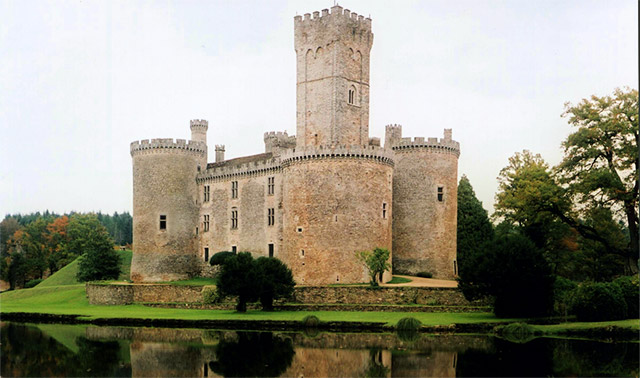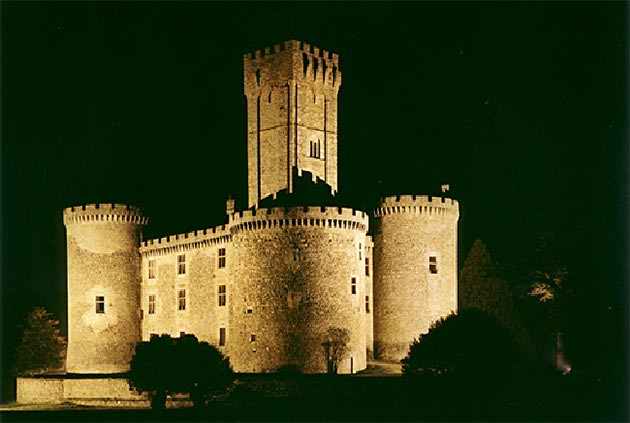L'histoire du château de Montbrun for sale
 Full of mysteries and numerous legends
Full of mysteries and numerous legends 

french castle of montbrun

montbrun castle guest bedroom

castle small diningroom

castle main diningroom

castle master bathroom

montbrun castle in france for sale

montbrun castle by night
The Castle of Montbrun with its origins, traceable, to over 2000 years ago. Full of mysteries and numerous legends. In the Roman time the lands here were called TRADOS; which, freely translated, means: Land of dispossession; whether this has to be explained in the sense of capitulation, indulgence, loyalty or submission is left in the middle by the Latin dictionary. In that time, the Celts lived here. It was a rich land (territory) and there were, according to the peoples account goldmines within its borders. For that reason, but possibly also to hide and to defend themselves against the, closely quartered, Roman legions, they built, aside the huts wherein they lived, a large and complex network of underground corridors and caves (cellars) which were connected to each other. Did the Celts, 2000 years ago, find it necessary to guard this valley with their underground paces,.. in approximately 500, the Franks built here a wooden castle tower and there was, apparently then, still a then obvious and clear reason.
Possibly it was the legendary treasure that, according to the peoples account, still is buried here.. But maybe there were also other motives..? In 1424 Montbrun was, on the order of the French King Charles the Seventh, under siege and attacked by one of his war-lords, because the then castle-lord Guy Brun, who was married to Angele, the sovereign of Pompadour, refused to submit to the authority of the King of France and remained loyal to his lord Henry the Sixth of England. Guy Brun perished during that fight and his wife Angele was banished to a nunnery. His younger brother, Pierre Brun, who was appointed by the Pope Martin the Fifth, as Arch-bishop of Limoges, became the new Lord of Montbrun; under the condition that he swore faith (loyalty) to the French Sovereign. In 1430 he started on the rebuilding of the family mansion, resulting in its present form. Pierre died on February 9, 1457 and left the castle with its lands to a second cousin: Louis Brun. In 1502, Jean Brun, the son of Louis, transformed this old and abandoned seigneurie into a chapel in the honour of Saint Andreas.
He married there in 1503 with Jacquette de Bourdeilles, the great love in his live, with whom

his father, till his death in 1501, had forbidden him to marry.
Their happiness would not last long; She died in 1504 during the birth of their daughter Elisabeth.
Elisabeth Brun married in 1516 at the age of 12, on de order of the French King Francois 1, with a person called Porthus d’Estuer de Causade. Their son, Louis d’Estuer was, however a loafer who, after her death, squandered the whole family-capital in the shortest of terms with partying and gambling. To then get his hands on money, he sold the estate with the castle on the 21st of May 1571, to the Count (earl) Francois de Lambertie. Louis died childless, drunk and impoverished, as they say, under piteous circumstances.
Francois Lambertie, through his excellent relations with the King, Charles the Ninth, transformed Montbrun into a Barony,
thus claiming two titles: that of Count (earl) of Lambertie and Baron of Montbrun.
Almost hundred years later, Marie, Countess of Lambertie and Baroness of Montbrun who was married to Hubert de Choisel,
died childless and without heirs. Montbrun came into the hands of one of her second cousins: Jean the Campniac.
In 1746 the last heir of this distantly to the Lamberties related family: Marie de Campniac, married to the Count (earl)
of Conan. Her grandson, Alexis became the last Lord of Montbrun, because there was disorder about in the land and the first
signs of the revolution announced themselves. His head did not fall under the guillotine; he succumbed, after his arrest
by the representatives of the proletariat, during the ride on the horse-wagon; on the way from Montbrun to the
peoples-tribunal in Paris.

Concept and Design - A.G.I. ( )  Photos - Andreas Caraisco ( website )
Photos - Andreas Caraisco ( website )
The Castle of Montbrun, Dournazac, Haute-Vienne, France.
Luxury Castle property for sale. ( )
Luxury Castle property for sale. ( )